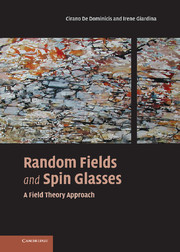Book contents
- Frontmatter
- Contents
- Preface
- List of abbreviations
- 1 A brief introduction
- 2 The Random Field Ising Model
- 3 The dynamical approach
- 4 The p = 2 spherical model
- 5 Mean field spin glasses: one-step RSB
- 6 The Sherrington–Kirkpatrick Model
- 7 Mean field via TAP equations
- 8 Spin glass above D = 6
- 9 Propagators, mostly replicon
- 10 Ward–Takahashi Identities and Goldstone modes
- 11 Alternative approaches and conclusions
- Appendix A Renormalization at one loop: ϕ4 theory (pure Ising)
- Appendix B Renormalization at one loop: tr ϕ3 theory (spin glass)
- Index
1 - A brief introduction
Published online by Cambridge University Press: 21 October 2009
- Frontmatter
- Contents
- Preface
- List of abbreviations
- 1 A brief introduction
- 2 The Random Field Ising Model
- 3 The dynamical approach
- 4 The p = 2 spherical model
- 5 Mean field spin glasses: one-step RSB
- 6 The Sherrington–Kirkpatrick Model
- 7 Mean field via TAP equations
- 8 Spin glass above D = 6
- 9 Propagators, mostly replicon
- 10 Ward–Takahashi Identities and Goldstone modes
- 11 Alternative approaches and conclusions
- Appendix A Renormalization at one loop: ϕ4 theory (pure Ising)
- Appendix B Renormalization at one loop: tr ϕ3 theory (spin glass)
- Index
Summary
Historically, this book started as a series of lectures given in the Service de Physique Théorique at Saclay, one of the lectures (Chapter 5 here) delivered by Marc Mézard. This explains the strong field theory bias adopted in its approaches and the use of some techniques rarely found in standard literature. It deals with the theory of disordered magnetic systems and for a large part of it with the Random Field Ising Model (RFIM) and the Ising Spin Glass, paradigmatic systems of frozen disorder. Such systems enjoy nontrivial properties, different from and richer than those observed in their pure (nondisordered) counterpart, that dramatically affect the thermodynamic behaviour and require specific theoretical treatment.
Disorder induces frustration and a greater difficulty for the system to find optimal configurations. Consider, for example, the case of spin glasses. These systems are dilute magnetic alloys where the interactions between spins are randomly ferromagnetic or anti-ferromagnetic. They can be modelled using an Ising-like Hamiltonian where the bonds between pairs of spins can be positive or negative at random, and with equal probability. Due to the heterogeneity of the couplings, there are many triples or loops of spin sequences which are frustrated, that is for which there is no way of choosing the orientations of the spins without frustrating at least one bond (Toulouse, 1977). As a consequence, even the best possible arrangement of the spins comprises a large proportion of frustrated bonds.
- Type
- Chapter
- Information
- Random Fields and Spin GlassesA Field Theory Approach, pp. 1 - 8Publisher: Cambridge University PressPrint publication year: 2006



